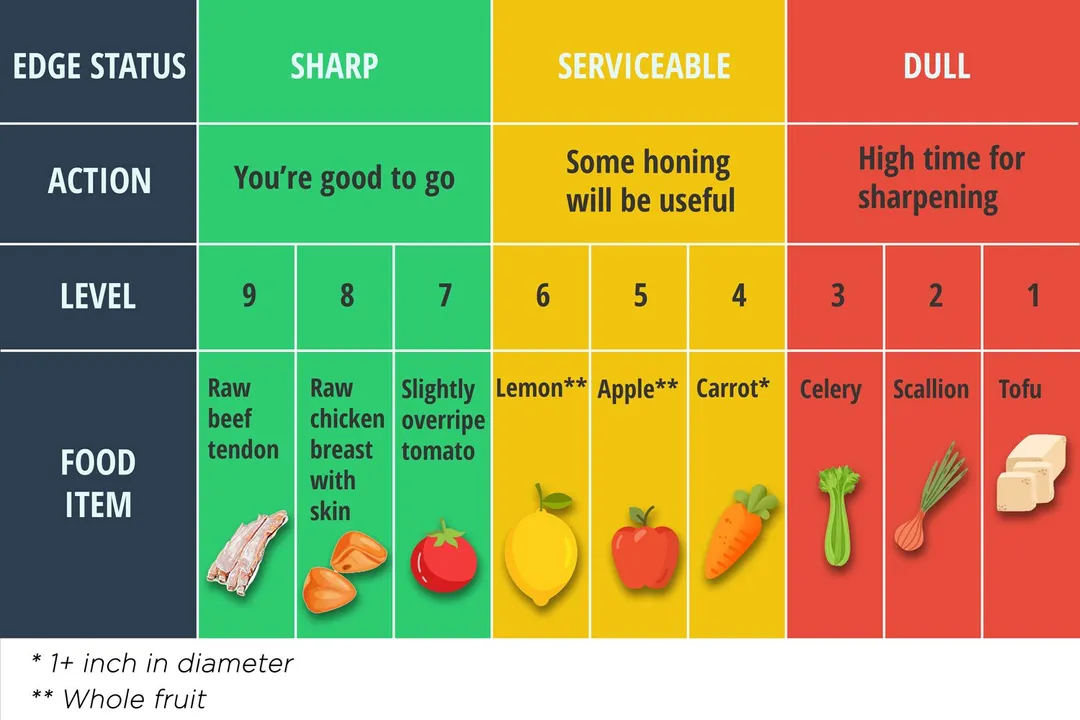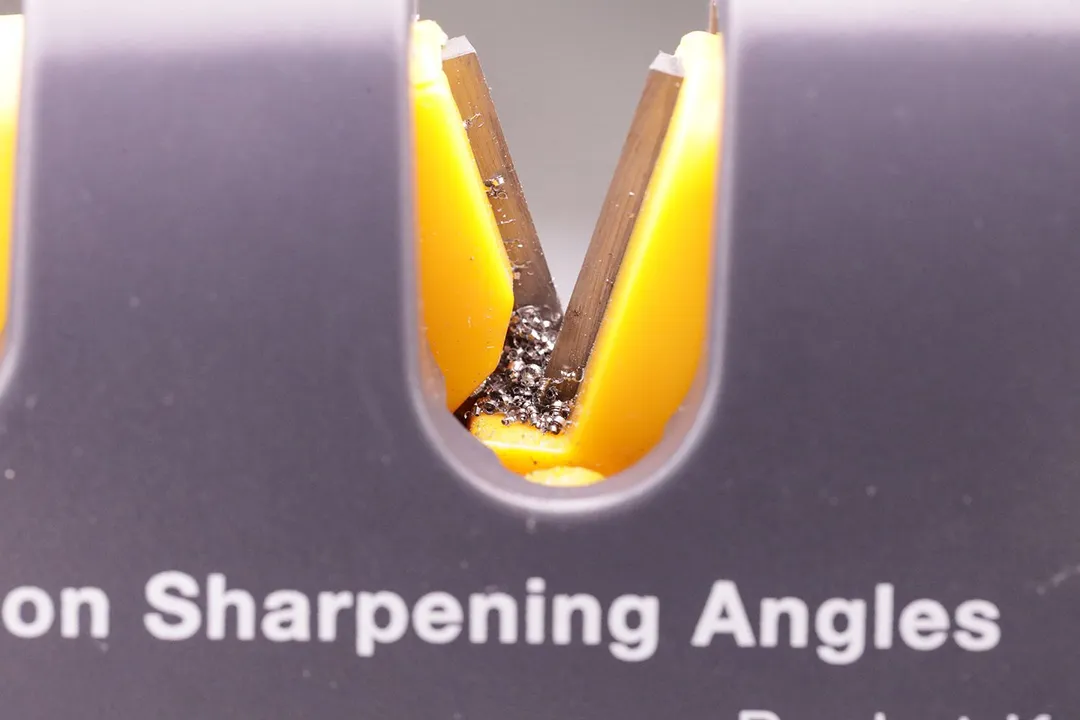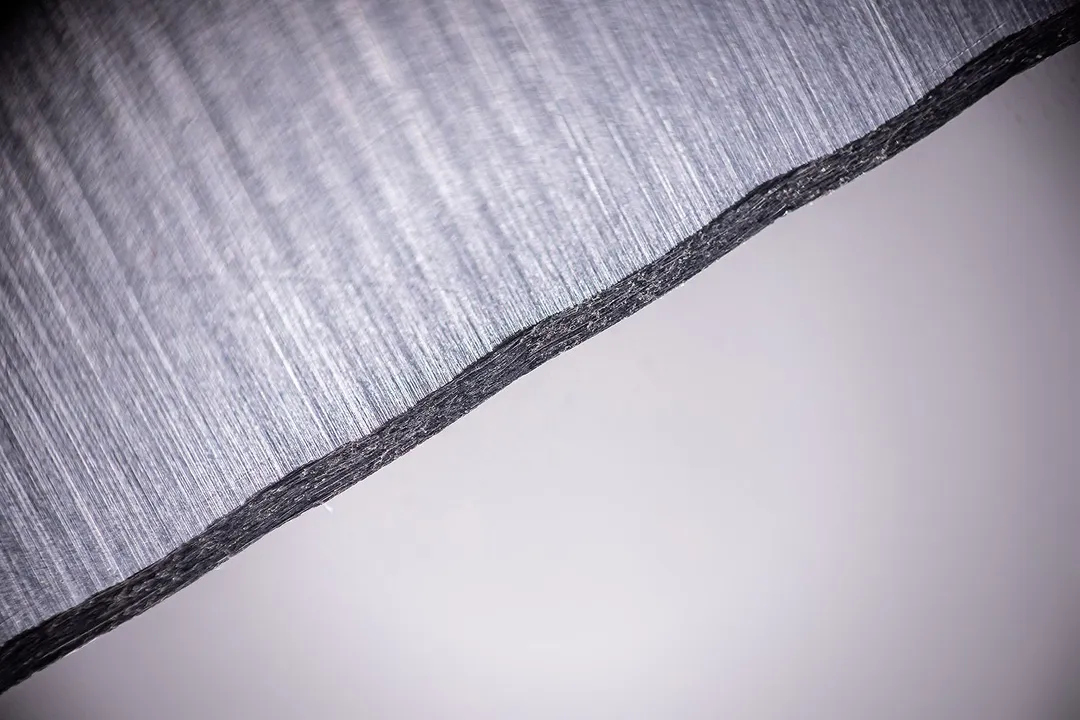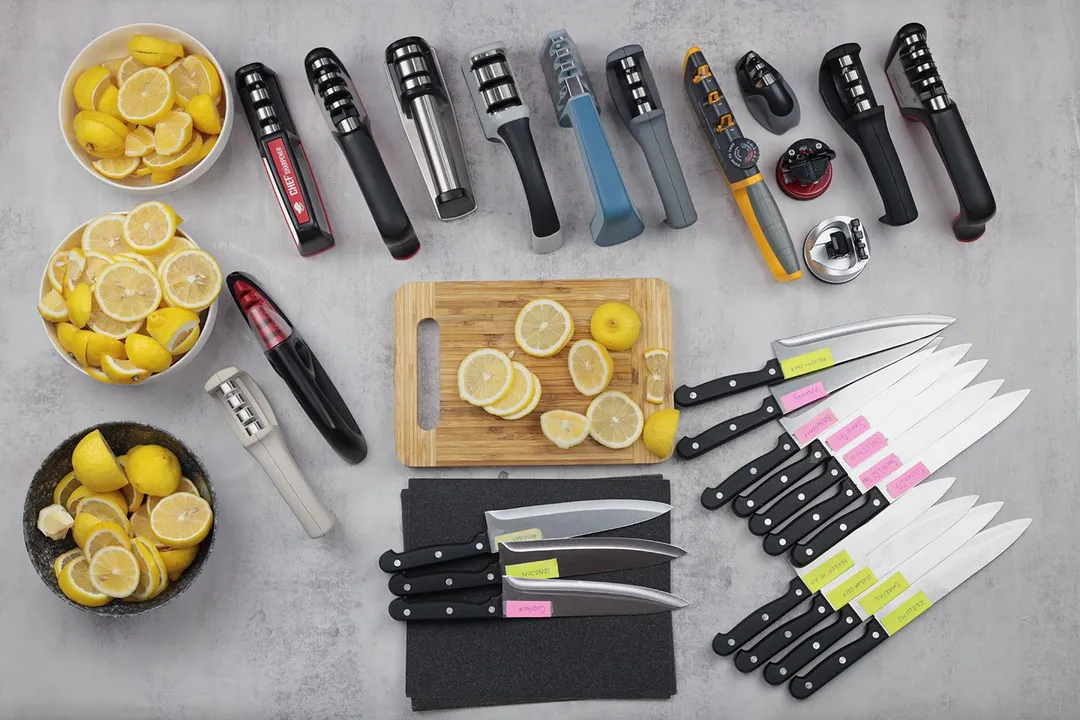Our recommendations are made independently through Research & Testing. We may receive commissions from purchases made via our links.
Maximum Sharpness for Manual Knife Sharpeners
We test knife sharpeners out on various food items to find out the maximum level of sharpness you can achieve with each sharpening device.
This test is part of How We Test Manual Knife Sharpeners v1.1
Exactly how sharp can your knives get with a handheld sharpener? This test, performed on all the sharpeners we come across, is designed to find out the highest level of sharpness you can achieve with each device within 6 minutes.
Why Maximum Sharpness Matters
Some sharpeners go beyond others in terms of how keen an edge they can produce. A device that can go higher on the sharpness scale allows you to handle a wider range of food prep tasks. It also offers the support you need to finish your food preparation tasks quickly and with better precision.

While sharpening may require significantly more time as you move up the scale, a keener edge will be serviceable for longer, thus requiring less frequent maintenance.
Therefore, although you can’t always expect razor-like results out of handheld sharpeners, this test is still worth considering before you buy a device.
Since excellent sharpness is a plus, not a must, we assigned the maximum sharpness test 20% of the Performance score.
How We Measure Knife Sharpness
We use the Practical Sharpness Scale to determine sharpness in all our sharpness tests for knife sharpeners. Though not highly accurate, this one is easy to understand and relatable for most home cooks.
It features nine levels of sharpness, measurable by the knife’s ability to cut through each of the food items listed using a single swipe with minimal force.

For more precise ratings of the sharpness level in our tests, we expanded the scale to include shades of gray between these levels. If a knife passes one level but needs two swipes to cut through the next level’s food item, we rate it with a minus. If it needs more than two swipes, it falls to the lower level number.
For example, if a knife can cut through a lemon with one swipe, but needs two swipes to cut through a slightly overripe tomato, it’s rated as Level 7-. If the same knife needs more than two effortless swipes to cut through the tomato, it stays at Level 6.
What’s New in V1.1
Most sharpener brands promise noticeable improvement ‘within a matter of seconds.’ We have another test for the time it takes to bring a knife to workable sharpness, but to find out the maximum level each device could give us, we use 6 minutes as the benchmark. A shorter duration may not be enough to reveal the device’s potential. A longer one would defeat the purpose of a ‘convenience sharpener.’
In our first version of the test, we allocated the 6 minutes equally among the sharpening stages on a device. For example, if a sharpener has three stages, we spent 2 minutes on each.
We eventually realized that it’s more effective to focus on sharpening the knife on the coarsest slot, and in this new version of the test, decided to do just that. We allocate 30 seconds to the prep slot and 30 seconds on each of the hining slots, if applicable.The remaining time of the 6 minutes is spent on the coarsest slot to get the knife as keen as possible.
Test Equipment
Here’s a list of what we use for the test.
- Sharpening device
- 8-inch, 20-degree chef’s knife
- Sandpaper
- A4 paper
- Stopwatch app
- Lemons, tomatoes, chicken breasts with skin on, and beef tendons, all fresh and raw.
The food items are those from the Practical Knife Sharpness Scale. We pick items starting from the highest Serviceable Level (Level 6 - Lemons) going all the way up to the top (Level 9 - Beef tendon).
The Testing Process
Here are the steps we take for the test.
Step 1. We blunt a knife by running it across sandpaper for 60 seconds and test it on a piece of A4 paper to make sure the desired bluntness is achieved. We try to make each test knife equally blunt.
Step 2. We run the knife through the sharpener for about 6 minutes, following the slot order as it is on the device. We spend 30 seconds on the prep or polish slots and the remaining time on the sharpening slot.
Step 4. We try the knife out on the food materials, progressing up the Practical Knife Sharpness Scale in order, and note down the results.
Scoring
Since beef tendon is the toughest food on the Sharpness Scale, a device that can bring your knife from dullness to that level gets 10 points. Every step below that on the scale marks a deduction of 2 points. Each extra swipe translates to a 1-point deduction.
Devices that failed to bring the test knife to Level 6 (Lemon) got 0 points.
Level | Food Item | Score |
|---|---|---|
6 - | Lemon, 2 swipes | 0 |
6 | Lemon, 1 swipe | 4 |
7 - | Ripe tomato, 2 swipes | 5 |
7 | Ripe tomato, 1 swipe | 6 |
8 - | Chicken breast with skin, 2 swipes | 7 |
8 | Chicken breast with skin, 1 swipe | 8 |
9 - | Beef tendon, 2 swipes | 9 |
9 | Beef tendon, 1 swipe | 10 |
Test Developers
Anh Ngo is a writer with 9 years experience at different media outlets, covering from public news and events to product testing and analysis. At HealthyKitchen101, she works across different departments, communicating closely with its network of writers, editors, and health, tech, and search engine experts to provide a meaningful and pleasant reading experience for visitors.
Lap is Head of the Research, Testing, and Review Team (RTR Team) at HealthyKitchen101.com, where he directs and supervises the testing of kitchen gadgets and appliances.
Nguyen Ntk is a graphic designer, photographer, and videographer whose philosophy centers around respecting and celebrating the beauty of reality. Through his lenses, Nguyen strives to capture the true essence of objects and events, showcasing and highlighting authentic features without distortion or exaggeration.





